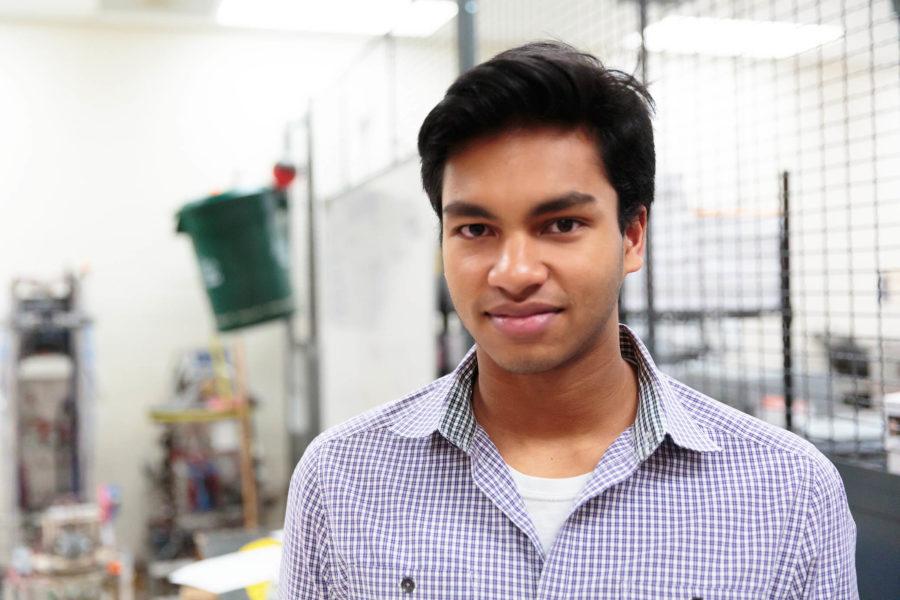Q&A with Senior Vikas Maturi
What was your invention?
My project was designing a device that’s called the intraocular injection guide that basically reduces the pain during the treatment of different eye diseases. Basically, during a normal eye injection they give it to you right in the white of your eye, but to do that safely they have to pry your eyelids apart with a kind of medieval device called a speculum. What happens is that a lot of patients actually experience a lot more pain from the speculum prying their eyelids apart than the injection itself. My device actually eliminates the need for the speculum, but still provides safe and more comfortable injections.
When did you create your invention?
I started working on the project the summer after my freshman year. I was volunteering at a medical office that my dad also worked at. I got to see these injections being given 30, 40, 50 times a day. I was really confused to why so many people were experiencing pain from this seemingly simple procedure. As I was seeing this I thought I could do something. I had just taken an IED (intro to engineering) class, so I had the skills to just kind of drop some models and from there it snowballed.
How did you create your invention?
I used a computer-aided designed software called “Autodesk Inventor”. Using that software, I came up with some basic models for the concept I had, and then I established some design constraints. With an engineering process you have some design constraints that you have to have your device meet. From there I modified the device over several months and eventually came up with the final product. I talked with different physicians that give these kind of injections and penciled with a couple different people just to make sure the device would make sense. Finally the device was tested in a clinical trial.
 Did you have any challenges or obstacles that you had to overcome while working on your project?
Did you have any challenges or obstacles that you had to overcome while working on your project?
Definitely. It actually started out just as a project I came across, but what happened was that as I went through the prototyping process each time I thought, this was going to be the final model. After one month, two months, 10 months I kept thinking it was going to be the final model. It ended up being a course of a year and a half before the final model was actually the final model. So just from there it was a lot of trying a new things and continuing to make modifications.
Where are you going to go from here with your project?
I’m looking into potential ways to mass produce the device. It’s cheaper to make the traditional speculum that’s currently used that’s more painful. I’m looking into contacting different biotechnology firms and one has taken an interest in it so far. Hopefully they will look into if this device could be manufactured on a large scale and what that would entail.
What do you envision doing in your future?
I’m interested in being a design engineer or a social designer, which basically involves engineering and interdisciplinary skills. They look at specific communities and design solutions to their problems that are directly affecting those communities.
What do you think you’ll take away the most from this experience with your project?
One of the biggest things I’ll take away is just trying something out. I never thought my project would get this far at all. I kind of submitted my work on a whim. In terms of advice, don’t feel that your project isn’t good enough or don’t feel weird by exploring what you’re passionate about. Also, the people that I met at the national finals. All those people were brilliant, incredibly interesting, and amazing in their own way. That was a really awesome part of it that I’ll definitely take away.































![What happened to theater etiquette? [opinion]](https://hilite.org/wp-content/uploads/2025/04/Entertainment-Perspective-Cover-1200x471.jpg)














































![Review: “The Immortal Soul Salvage Yard:” A criminally underrated poetry collection [MUSE]](https://hilite.org/wp-content/uploads/2025/03/71cju6TvqmL._AC_UF10001000_QL80_.jpg)
![Review: "Dog Man" is Unapologetically Chaotic [MUSE]](https://hilite.org/wp-content/uploads/2025/03/dogman-1200x700.jpg)
![Review: "Ne Zha 2": The WeChat family reunion I didn’t know I needed [MUSE]](https://hilite.org/wp-content/uploads/2025/03/unnamed-4.png)
![Review in Print: Maripaz Villar brings a delightfully unique style to the world of WEBTOON [MUSE]](https://hilite.org/wp-content/uploads/2023/12/maripazcover-1200x960.jpg)
![Review: “The Sword of Kaigen” is a masterpiece [MUSE]](https://hilite.org/wp-content/uploads/2023/11/Screenshot-2023-11-26-201051.png)
![Review: Gateron Oil Kings, great linear switches, okay price [MUSE]](https://hilite.org/wp-content/uploads/2023/11/Screenshot-2023-11-26-200553.png)
![Review: “A Haunting in Venice” is a significant improvement from other Agatha Christie adaptations [MUSE]](https://hilite.org/wp-content/uploads/2023/11/e7ee2938a6d422669771bce6d8088521.jpg)
![Review: A Thanksgiving story from elementary school, still just as interesting [MUSE]](https://hilite.org/wp-content/uploads/2023/11/Screenshot-2023-11-26-195514-987x1200.png)
![Review: "When I Fly Towards You", cute, uplifting youth drama [MUSE]](https://hilite.org/wp-content/uploads/2023/09/When-I-Fly-Towards-You-Chinese-drama.png)
![Postcards from Muse: Hawaii Travel Diary [MUSE]](https://hilite.org/wp-content/uploads/2023/09/My-project-1-1200x1200.jpg)
![Review: "Ladybug & Cat Noir: The Movie," departure from original show [MUSE]](https://hilite.org/wp-content/uploads/2023/09/Ladybug__Cat_Noir_-_The_Movie_poster.jpg)
![Review in Print: "Hidden Love" is the cute, uplifting drama everyone needs [MUSE]](https://hilite.org/wp-content/uploads/2023/09/hiddenlovecover-e1693597208225-1030x1200.png)
![Review in Print: "Heartstopper" is the heartwarming queer romance we all need [MUSE]](https://hilite.org/wp-content/uploads/2023/08/museheartstoppercover-1200x654.png)



